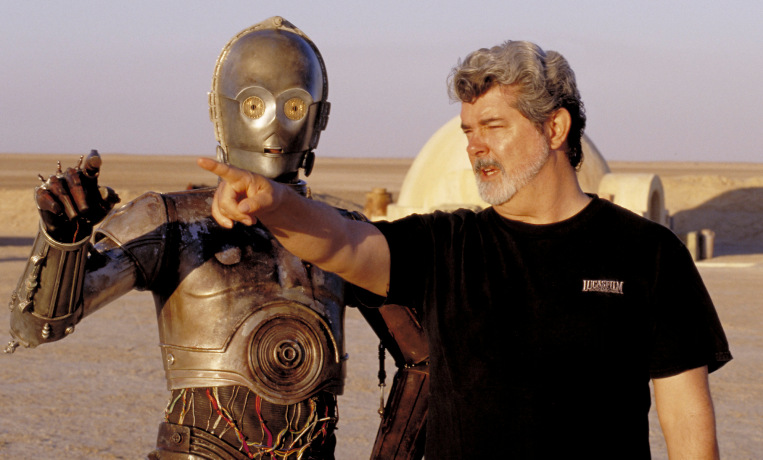
It was the summer of 1977 when I sat in a small dark theater in Moore Oklahoma and saw “Star Wars” for the first time. What I saw on that screen was unlike anything I’d ever seen before and it changed my life.
While most of my friends went to see “Star Wars” and wanted to be Luke Skywalker or Han Solo, I had a different hero. I wanted to be George Lucas.
Even as a kid, I understood that someone was the creator of that universe. That someone sat down and penned the story, the characters, the history and the world that blew me away. George Lucas awakened in me a desire to create that has guided many of my life decisions from that point forward.
I’m not alone. George Lucas has influenced two generations of writers, artists, video game designers and movie-makers. Given the continued and amazing success of Star Wars after his sale to Disney, I wanted to take a moment and praise George Lucas for all he’s given us and how he’s changed the movie industry, inspired creative people of all types and changed the lives of millions of fans.
The last twenty years Lucas has taken a lot of criticism from his greatest fans, me included. This is meant to be a laudatory piece, so I’m not going to dwell on what upset me and so many others. It started with certain decisions in “Return of the Jedi,” was exacerbated by some of the changes he made to the original films upon re-release and was codified with the prequel movies, particularly “The Phantom Menace.”
Those criticisms are well-documented elsewhere, by people who are much more thorough than I could ever be. What was missing from most of those diatribes were two things; our love for George Lucas and for the universe he created. Because after all, why would we care otherwise?
Rebel with a Cause
Let’s not forget what a rebel and visionary that George Lucas was in the 70’s. Hot off his success with “American Graffiti,” instead of playing it safe, he used his clout to shop “Star Wars” around numerous movie studios and encountered great resistance to his space epic. It was Alan Ladd Jr. at 20th Century Fox that finally gave him the green-light and changed the way movies were created and monetized forever.
While negotiating his contract for Star Wars, Lucas cut his directing fee to $500,000 in exchange for something that 20th
Century Fox thought was worthless – ownership of the film’s merchandising and sequel rights. The way that Lucas used merchandising and sequel rights to build an empire could be seen as the biggest upheaval in the movie business ever.
Truly Special Effects
Under the guidance of Lucas, special effects Jedi John Dykstra and his team used computer-controlled motion photography and unprecedented compositing to give us the space battles we saw in 1977. The success of “Star Wars” led to the creation of Industrial Light and Magic. ILM has been responsible for the visual effects in nearly 300 films, including the Star Wars films, the Indiana Jones series, the Harry Potter series, the Jurassic Park series, the Back to the Future trilogy, the Transformers films and even Avatar alongside Weta Digital.
A Revolution in Animation
The Graphics Group, a part of the computer division of Lucasfilm, was spun off with investment money from Steve Jobs and became Pixar Animation Studios. Pixar has created 16 feature films, beginning with “Toy Story” in 1995 and has gone on to make $9.5 billion worldwide and win 15 Academy Awards. Pixar also single-handedly uprooted the long-standing domination of hand-drawn animated movies by Disney, who ironically bought the company in 2006.
The Deep Note
THX, an audio/visual reproduction standard, was developed by audio scientist Tomlinson Holman to ensure that the soundtrack for “Return of the Jedi” would be accurately portrayed in theater venues. What Holman discovered was that most theaters had not seen significant technology improvements since World War II. His experimental work at Skywalker Ranch led to certification standards that revolutionized the movie-going experience for all of us.
“While filmmakers were spending millions of dollars and using new computer technology to perfect the sound and picture in the post-production studio, the quality was being lost on movie audiences,” said John Dahl, director of education and resident historian at THX Ltd. “By creating a set of standards for theater design and enforcing performance levels of presentation equipment, THX was ensuring that the film experience would translate from studios to every theater.”
Some Praise for the Prequels
George Lucas continued to change the movie industry with his work on the prequel films. “Attack of the Clones” was the first major Hollywood feature to be captured digitally. His extensive use of computer-generated sets and motion-capture paved the way for movies like “300,” “Sin City” and “Avatar.”
Cinematography in Hollywood is now predominantly digital, and that’s because of the trailblazing by Lucas. “American Cinematographer” gave George Lucas this distinction,
“Today it can be said that few have impacted the craft of filmmaking more than he has. The ultimate noodler who enjoys seeing his films come together in editing, Lucas has transformed the medium into a postproduction fantasia.”
While we’re on the subject of the Star Wars prequels let’s give credit where it’s due. The overall plot of the prequels was far more complex than the original trilogy. The action sequences were thrilling and so intricate that they continue to offer surprises with additional viewings. Maybe most important, it expanded the Star Wars universe and proved that the appetite for more stories was, and is, alive and well.
The Blockbuster Series
Furthermore, would Hollywood have seen the potential payoff in backing a risky expensive connected series of films if Lucas had not made both Star Wars trilogies? Without Star Wars would there have been The Lord of the Rings or Harry Potter movies? Would the Marvel Cinematic Universe exist? Lucas led the way and Hollywood learned how to tell stories with multiple films.
The Light and Dark Side
Regularly referred to as both gentle and kind, Lucas sat out to create a new morality tale with “Star Wars.” In doing so, his story of good-versus-evil has re-taught the world concepts like self-sacrifice, the power that comes with resisting temptation and eternal life for those who choose the light. Through his character’s stories and through dissertations on “The Force,” Lucas gave us a roadmap on how to be a better person.
A Heartfelt Thanks
Almost anyone who enjoys movies today owes a debt of gratitude to George Lucas. Even if you detest blockbusters, what he did to bring new technology and standards to the film industry is unparalleled. And for those of us who found joy and inspiration from the Star Wars movies, we are doubly indebted.
Once Lucas decided to part ways with Star Wars he could have stuck it on a shelf and let it rot. Despite all the bitterness over the last two decades of criticism, Lucas followed his own teachings and did what one of his Jedi characters would have done… he gave up his greatest work so that it could live on in the hands of new creators. Much like the morality tales of the past, Star Wars will live on forever.
A lesser man would have held the Star Wars universe like Gollum held The One Ring, but he loved us and his work enough to let it go.
More on George Lucas and sources:
Star Wars Revolutionized Special Effects Twice; Can It Do It Again?
Image copyright Lucasfilm.
